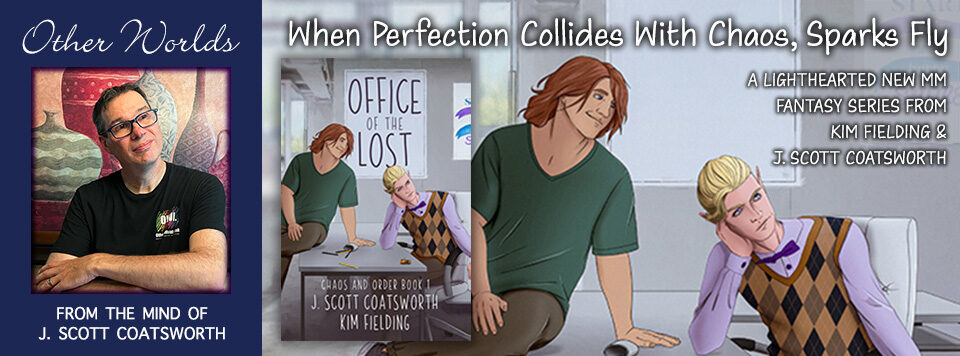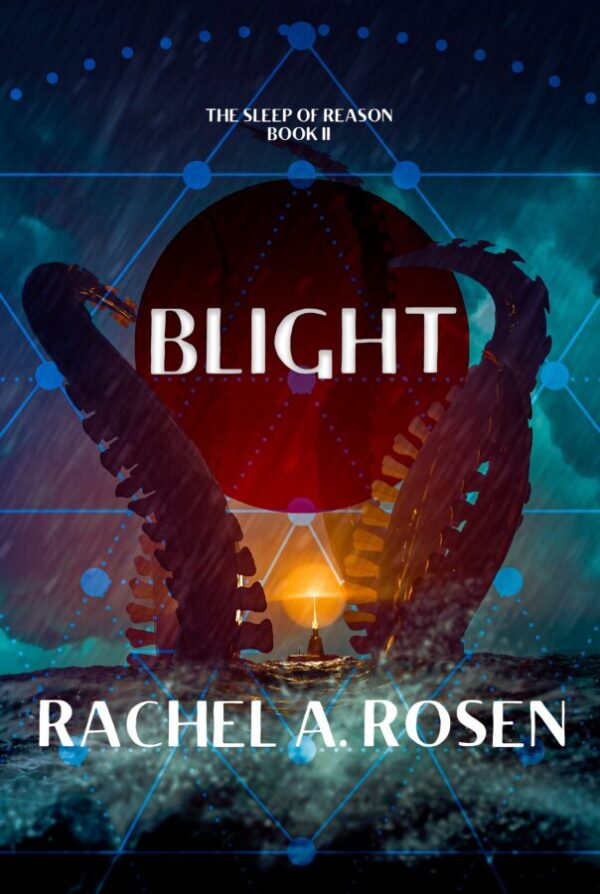
Welcome to my weekly Author Spotlight. I’ve asked a bunch of my author friends to answer a set of interview questions, and to share their latest work.
Today: Rachel A. Rosen is an activist, graphic designer, and for her sins, a high school teacher. In a previous life, she published two long running anarchist ‘zines and designed the uniform for the Christie Pits Hardball League.
She is the author of Cascade, this novel’s predecessor, and, with Zilla Novikov, the co-author of The Sad Bastard Cookbook: Food You Can Make So You Don’t Die. More of her writing can be found in Beyond Human: Tales of the New Us, Instant Classic (That No One Will Read), and The Dance. Rachel co-hosts the Wizards & Spaceships podcast with David L. Clink (www.wizardsandspaceships.ca), and designs book covers in her theoretical spare time.
She lives in Tkaronto (Toronto), where she is the harried personal assistant to two cats. Her website is www.rachelrosen.ca.
Thanks so much, Rachel, for joining me!
J. Scott Coatsworth: Why did you choose to write in your particular genre?
Rachel A. Rosen: Both Cascade, my first novel, and Blight, its sequel, are fantasy, and all of my short stories published thus far are fantasy or science fiction. Speculative fiction, broadly defined, has incredible potential for social change, and if there’s one recurring theme in all of my writing, it’s the human capacity for fighting back against injustice. I adore reading realist fiction; it’s very good at pointing out the horrors of the world and the flaws of the individual. But it’s limited by the scope of the possible, whereas speculative fiction is only limited by how much you can get a reader to suspend their disbelief. That scope of play is crucial because you can’t build what you can’t imagine.
JSC: How do you combine all the different worlds of your life in your works?
RAR: A lot about my writing is my various special interests spewed over the page, which I hear some people are into. Accordingly, past the politics and wizards and eldritch horrors beyond contemplation, you get people singing opera and referencing art history and doing puppet shows and engaging with online fandom and leftist sectarians having lengthy digressions about whales and lichen. I like to think that it creates a rich text. A very rich, very weird text. If you enjoy watching an author get really passionate about obscure and esoteric nonsense then you are in for a ride.
JSC: What were your goals and intentions in Blight, and how well do you feel you achieved them?
RAR: Officially speaking and for the purposes of any security agency reading this interview, I wasn’t setting out to write a how-to for resisting fascism. But I definitely wanted to respond to a lot of the flaws I see in terms of how fiction, and in particular speculative fiction, depicts resistance to tyranny and revolutionary movements. I wanted to depict a rebellion that didn’t keep its hands clean of innocent blood, that contained multiple factions that might have diverging short- or long-term interests, and I wanted to show that revolutionary struggle is as much feeding people and enduring boring meetings as it is fun adventures where you’re running around with guns. I wanted to show the moral compromises inherent in engaging with politics. And I wanted to show what activist burnout looks like. All, hopefully, without didacticism and with a generous helping of dysfunctional queer relationships.
JSC: Who did your cover, and what was the design process like?
RAR: I freelance as a cover designer, where I work in collaboration with the author to find the perfect visual metaphor for their novel. But, in news that surprises no one, it’s hard to collaborate with the author when you are the author. So I brought in a second pair of eyes, the incredible Marten Norr, who I’ve worked with before on several other projects—he was the illustrator for The Sad Bastard Cookbook and designed the logo for my podcast, Wizards & Spaceships, among others. Not only is he talented, but he shares my love of deep-sea eldritch horrors and didn’t so much as blink when I asked him to design menacing bone tentacles.
JSC: What inspired you to write Blight? What were the challenges in bringing it to life?
RAR: Blight is the story I started writing first, back when I thought I’d be done in one book, and before I realized that my actual storyline began three years before its first scene. The direct inspiration was the Quebec Charter of Values, introduced in 2013. It was certainly not the first authoritarian, Islamophobic, boneheaded bit of legislation to show up in Canada, but it coincided with the early stirrings of a rise in fascism worldwide. It was also one that highlighted the discrepancy between how we see ourselves as a country—polite, tolerant, multicultural—and how we actually are, which is three oil companies in a trenchcoat doing colonialism here and abroad. Our norms and stated values are only powerful through a magical spell, which is the belief that they’re real and enforceable. And like the wards in Blight, this spell must be constantly recharged, lest everything fall apart. The degree to which the fundamental pillars of our society—the economy, our legal system, our politics—are based in what’s essentially collective magic belief is something that gets more fascinating the more I learn about it.
The challenge is in making that fairly weighty topic interesting to someone who isn’t already a massive nerd interested in political theory. And for that, you need compelling characters. There are already plenty of cishet young adult protagonists in dystopian novels charmingly bumbling their way through love triangles and palace coups, so mine are queer, middle-aged, and hellbent on dismantling the systems that they once tried to salvage.
JSC: What pets are currently on your keyboard, and what are their names?
RAR: That would be Sabot, my little angel baby who sits quietly with me while I write and purrs, and a hand grenade in the shape of a cat, Alice, who is 15 pounds of unmitigated chaos.
JSC: What other artistic pursuits (if any) do you indulge in apart from writing?
RAR: I’m a book designer, which dovetails nicely with writing. Besides that, I paint and bead, and recently I’ve been getting into digital illustration and 3D modelling. I’m also a podcaster now, which is such an inevitable development that it’s amazing that we weren’t subjected to it much earlier.
JSC: We know what you like to write, but what do you like to read in your free time, and why?
RAR: I’m all over the place in terms of my reading—my goal is always 50% from my genre, 50% outside of it (including nonfiction). A lot depends on what comes up in my rotation of library holds. I would say though, a significant amount of what I read these days is literary fiction by Indigenous authors, both because I think that this is some of the best and most challenging work out there right now, and also because I teach Indigenous lit at work and need to keep up to date.
JSC: What qualities do you and your characters share? How much are you like them, or how different are they from you?
RAR: My characters are the worst and best facets of my own personality. They’re my anxiety, my anger, my insecurities, my cowardice, and they’re also the part of me that’s willing to burn myself out if that’s what it takes to make a better world.
I’m more like some than others. Maya’s transformation from beleaguered intern with imposter syndrome to anarchist revolutionary, still with imposter syndrome, is about 50% autobiographical. Ian’s narrative arc is very much about my own experience of disability and forging meaning when pain and rage have changed the person that you thought you were. Blight is about a fight that has, in many ways, already been lost, and as someone who’s been involved in left-wing activism for most of my life, the struggle to persevere in the face of that loss is something that I share with all of my characters.
JSC: Would you rather be in a room full of snakes or a room full of spiders?
RAR: As a goth and someone with a phobia of cockroaches, I’m a big fan of both. I would prefer snakes, though. While I’m not scared of either, I am afraid of accidentally stepping on one and squishing it and that is far less likely to happen with snakes, as they’re easier to spot. Also, I find snakes cuter and many of them are quite friendly and enjoy being booped on the snoot, something you probably shouldn’t attempt with spiders.
JSC: What are you working on now, and what’s coming out next? Tell us about it!
RAR: My big project is the third and final book in the Sleep of Reason series, tentatively titled Braid. Since that’ll be a while in the making, I also have several other projects in the works, including two short stories, both named after internet memes because I’m like that. And of course, there’s season 2 of Wizards & Spaceships, which features episodes on the Epic of Gilgamesh, cyberpunk, space battles, and more!
And now for Rachel’s latest book: Blight:
What use is a revolution in a world ruled by magic?
A young wizard on the brink of burnout searches for her lost mentor. A bereaved mother, summoned to the sea by an ancient god, risks all to avenge her child. Her ex-husband smuggles weapons to a rag-tag resistance.
The Cascade ruined the world that was; the Blight nearly destroyed what remained. The magical catastrophe unleashed demons and shriekgrass, an endless winter, and a promise of worse to come.
In what remains of Canada, the genocidal Dominion government rules with an iron fist, while the libertarian Silicon Valley Autonomous Region chips away at the country’s sinking west coast.
Can a restive coalition of revolutionaries, defectors, and magicians pick up the pieces?
Publisher | Amazon | iBooks | Barnes & Noble | Kobo | QueeRomance Ink | Smashwords | Universal Buy Link
Excerpt
The Milky Way stretched across the sky like a wound.
They had rolled up their camping gear in the failing light of dusk, hiked the trails adjacent to the road. It was the more difficult route, but it rendered them nearly invisible to surveillance drones. At moonrise, the outcrops of rock became crooked old men, a giant fist raised, in rage, to the heavens.
What conversation there had been, was only a breathy, “this way” or “watch for the branch,” quiet enough to hear six sets of breaths, ranging from the infant’s snuffles to the man’s irritated rasps, to hear the swishes and sighs where the forest gave way to them.
Quiet enough to hear when something else was moving through the trees.
These are the things that, according to common wisdom, kept away a demon: salt, fire, wards, bullets, prayer. A large enough flamethrower, if you could find the gas to power it. Concrete walls.
These are the things that, according to Blythe’s experience, kept away a demon: absolutely fucking nothing, if it really wanted to get at you. It would unhinge its jaws and swallow you before you could reach for your gun. It would have claimed your mind long before that. You would walk, smiling, into its rotting arms as it sang your name.
She felt their presence before the temperature dropped, a needle-bright jab that danced over the labyrinth tattoo on her shoulder. Leave it to Ian fucking Mallory to bestow her with an advanced warning system that told her only of a fate she couldn’t avoid.

